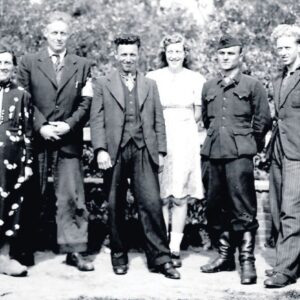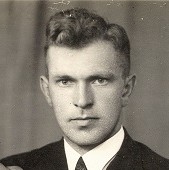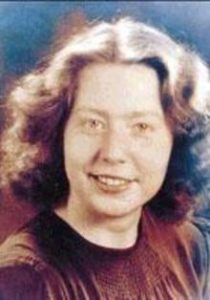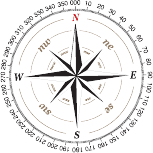Douma, Catrinus, born 06-06-1917 in the hamlet of Dijkshorne  near Ee in Friesland, the fourth son to Jan Douma, a dike worker and small farmer, and Elisabeth de Roos; they named him Catrinus. After elementary school, he attended secondary school in Dokkum, and later also took a course in Agricultural Management. Cartrinus worked as a representative for a trading company in Groningen. In this capacity, he was involved in the grain trade, dealing in seeds, seed potatoes, and pesticides. Meanwhile, he had met Emmy Vellinga
near Ee in Friesland, the fourth son to Jan Douma, a dike worker and small farmer, and Elisabeth de Roos; they named him Catrinus. After elementary school, he attended secondary school in Dokkum, and later also took a course in Agricultural Management. Cartrinus worked as a representative for a trading company in Groningen. In this capacity, he was involved in the grain trade, dealing in seeds, seed potatoes, and pesticides. Meanwhile, he had met Emmy Vellinga  from Schiermonnikoog. In May 1937, he settled in Slootdorp as a commission agent at Koolhaas Zaadhandel. He boarded with the Van der Beek family at Koningin Emmaweg 3 in Slootdorp
from Schiermonnikoog. In May 1937, he settled in Slootdorp as a commission agent at Koolhaas Zaadhandel. He boarded with the Van der Beek family at Koningin Emmaweg 3 in Slootdorp  . Emmy, his girlfriend, also came to Wieringermeer and worked for the Jacobi family on Wierweg. They got engaged on 31-07-1943.
. Emmy, his girlfriend, also came to Wieringermeer and worked for the Jacobi family on Wierweg. They got engaged on 31-07-1943.
When the war begins, Catrinus Douma quickly becomes involved in the resistance. He joins the National Organization for Aid to People in Hiding (L.O.).  He is the founder of the Trouw group (illegal press) as well as the Internal Armed Forces (BS)
He is the founder of the Trouw group (illegal press) as well as the Internal Armed Forces (BS)  in the Wieringermeer. He was also involved in supporting (striking) railway workers.
in the Wieringermeer. He was also involved in supporting (striking) railway workers.
The Trouw group in Wieringermeer  published a news bulletin
published a news bulletin  that was distributed to one in every five house numbers for onward transmission to the other four addresses. In the beginning (late 1944), this bulletin appeared three times a week, later almost daily. The news was obtained by listening to the BBC (Radio Oranje)
that was distributed to one in every five house numbers for onward transmission to the other four addresses. In the beginning (late 1944), this bulletin appeared three times a week, later almost daily. The news was obtained by listening to the BBC (Radio Oranje)

 in the evenings at the home of wage earner Eppe Zuidema
in the evenings at the home of wage earner Eppe Zuidema

 in Slootdorp, who was one of the few people who still had electricity because of his work.
in Slootdorp, who was one of the few people who still had electricity because of his work.
The news was typed on a stencil by Marinus Meeuwsen  and reproduced early the next morning at Ridder’s office in Middenmeer. This work was done by Mr. R. J. Ridder and Bep Lindenbergh
and reproduced early the next morning at Ridder’s office in Middenmeer. This work was done by Mr. R. J. Ridder and Bep Lindenbergh  . The deliverers, mostly people in hiding who were unfamiliar with the area, received the bulletins in envelopes. The news was then distributed using addresses memorized by heart. Amazingly, this procedure always worked well.
. The deliverers, mostly people in hiding who were unfamiliar with the area, received the bulletins in envelopes. The news was then distributed using addresses memorized by heart. Amazingly, this procedure always worked well.
In 1943, Catrinus Douma became one of the district leaders of the L.O. (Resistance Organization) in the northern part of North Holland. His membership card states: district Heerhugowaard. This district included Anna Paulowna, Den Helder, Kolhorn, Wieringen, Wieringerwaard, and northeastern Wieringermeer, Oude and Nieuwe Niedorp, St. Pancras, Broek op Langedijk, Noord- and Zuid-Scharwoude, Oudkarspel, Spanbroek, and Tuitjenhorn.
As far as Wieringermeer was concerned, Douma regularly met with other district leaders, often in the vestry of the Reformed Church in Slootdorp. Regular attendees at these meetings were Adriaan Cornelis (Adrie) de Graaf  , Sicco Leendert Mansholt
, Sicco Leendert Mansholt  , Gerrit J Blaauboer, Johannes Willem .J. (‘master’) Aalders
, Gerrit J Blaauboer, Johannes Willem .J. (‘master’) Aalders  , and many others from outside Wieringermeer. As a representative of the grain industry, it was obvious that Catrinus was involved in food supply. He arranged for the purchase and delivery of grain, legumes, and potatoes to the resistance in places such as Zaandam, Alkmaar, Hilversum (‘t Gooi), and Amsterdam.
, and many others from outside Wieringermeer. As a representative of the grain industry, it was obvious that Catrinus was involved in food supply. He arranged for the purchase and delivery of grain, legumes, and potatoes to the resistance in places such as Zaandam, Alkmaar, Hilversum (‘t Gooi), and Amsterdam.
During the hunger winter of 1944-1945 in particular, many food transports were carried out, often with forged German papers. During the war, inspectors from the Food Supply Control Service had to keep track of supplies in the polder and carry out counts. Grains, legumes, chickens, livestock, everything was counted. But what was not counted, often deliberately, or was supposedly stolen, was passed on to Catrinus Douma. And he arranged for it to go to a completely different destination.
Through his contacts with the L.O. in Hilversum, the Sicherheitsdienst (S.D.) ![]() must have been on Douma’s trail. During an arrest in Hilversum on 23-01-1945, Gerrit.J. van Wetering was among those arrested. Van Wetering regularly obtained food from the Wieringermeer and used forged documents; the stamp used for this was found at Van Wetering’s home.
must have been on Douma’s trail. During an arrest in Hilversum on 23-01-1945, Gerrit.J. van Wetering was among those arrested. Van Wetering regularly obtained food from the Wieringermeer and used forged documents; the stamp used for this was found at Van Wetering’s home.
Be that as it may, it can hardly have been a coincidence that on 31-01-1945, four people in civilian clothing (SD) arrived at Catrinus Douma’s boarding address in Slootdorp and asked for him.
Marinus Meeuwsen, who was working at Ridder’s office at the time, witnessed the incident at the stock exchange:”The last thing I saw of Catrinus was him leaving the stock exchange before it closed. But you could expect Catrinus to receive many people I didn’t know. That’s how it was in the trading world. When he was arrested, I didn’t realize that it was an enemy arrest. I could still point out the spot where I was standing when Catrinus was led away from the trading floor between two men…”
Upon returning to his lodgings in Slootdorp, Catrinus Douma was forced to go inside to collect his personal belongings. There, a forged stamp from the  was found, which he had received from Den Helder just the day before. After his deportation, his fiancée warned the Jacobi family, because Jewish people in hiding were staying with them. She herself decided to play it safe and left via the Afsluitdijk to stay with an uncle in Dokkum. The distribution of illegal news reports in the polder was taken over by Warner Cornelis ten Kate
was found, which he had received from Den Helder just the day before. After his deportation, his fiancée warned the Jacobi family, because Jewish people in hiding were staying with them. She herself decided to play it safe and left via the Afsluitdijk to stay with an uncle in Dokkum. The distribution of illegal news reports in the polder was taken over by Warner Cornelis ten Kate  .
.
Death and burial ground of Catrinus Douma.

A description of that fateful day, 09-02-1945,Catrinus and what preceded the murder of ten resistance fighters, can be found in the memorial book Sta een ogenblik stil… in Zaanstad (Pause for a moment… in Zaanstad).
“On the corner of Prins Hendrikkade and Burcht in Zaandam, 
 a memorial stone hangs on the facade of a house. The people named on the memorial stone were shot there on Friday, 09-02-1945, at a quarter to ten. Ten of them lined up in a row, their backs to the water, and then the soldiers fired their weapons. Why is not known. Perhaps it had something to do with what happened earlier that week in Zaandam. Twice, a traitor had been shot by members of the resistance near the old town hall. A baker’s son and a policeman who were not only ‘wrong’, but also traitors. Of course, there were more people who sided with the Germans, members of the NSB (Dutch National Socialist Movement)
a memorial stone hangs on the facade of a house. The people named on the memorial stone were shot there on Friday, 09-02-1945, at a quarter to ten. Ten of them lined up in a row, their backs to the water, and then the soldiers fired their weapons. Why is not known. Perhaps it had something to do with what happened earlier that week in Zaandam. Twice, a traitor had been shot by members of the resistance near the old town hall. A baker’s son and a policeman who were not only ‘wrong’, but also traitors. Of course, there were more people who sided with the Germans, members of the NSB (Dutch National Socialist Movement)  under command of Anton Adrian “Ad” Mussert
under command of Anton Adrian “Ad” Mussert 
 for example. They were not simply eliminated. Traitors were a degree worse; they helped the Germans track down people who were involved in the resistance. Traitors were therefore extremely dangerous.
for example. They were not simply eliminated. Traitors were a degree worse; they helped the Germans track down people who were involved in the resistance. Traitors were therefore extremely dangerous.
A funeral director, who was a sympathizer of the NSB, had to bury the executed men in a mass grave. In May 1945, on his instructions, the grave was opened in the presence of two of Catrinus’ brothers and two doctors. A few pieces of clothing, together with the death certificate, were taken to Friesland to show to the parents. A plaque bearing the ten names was later hung at the site of the execution, on Prins Hendrikkade in Zaandam.
In the summer of 1945, it became clear that the remains of 422 people who had been executed were buried in 45 different graves in the dune area near Overveen: 421 men and 1 woman. The woman was resistance girl, Jannetje Johanna “Hannie” Schaft, age 24, 
 who was murdered on 17-04-1945.
who was murdered on 17-04-1945.
Many relatives want resistance fighters to be given a communal resting place. This gave rise to the idea for the Bloemendaal Cemetery of Honor.  Near the cemetery, red granite memorial stones have been placed at eight locations in the dunes where human remains were found.
Near the cemetery, red granite memorial stones have been placed at eight locations in the dunes where human remains were found.  Catrinus Douma, who lived in Wieringermeer, is also buried here. Douma was someone who risked his life to “save fellow citizens from starvation,” according to his mother. Someone who “did everything out of principle,” declared loondorser Zuidema. And who, “as a devout Christian, felt compelled by this work to serve God and his country,” according to his brother P. Douma.
Catrinus Douma, who lived in Wieringermeer, is also buried here. Douma was someone who risked his life to “save fellow citizens from starvation,” according to his mother. Someone who “did everything out of principle,” declared loondorser Zuidema. And who, “as a devout Christian, felt compelled by this work to serve God and his country,” according to his brother P. Douma.
















Leave a Reply